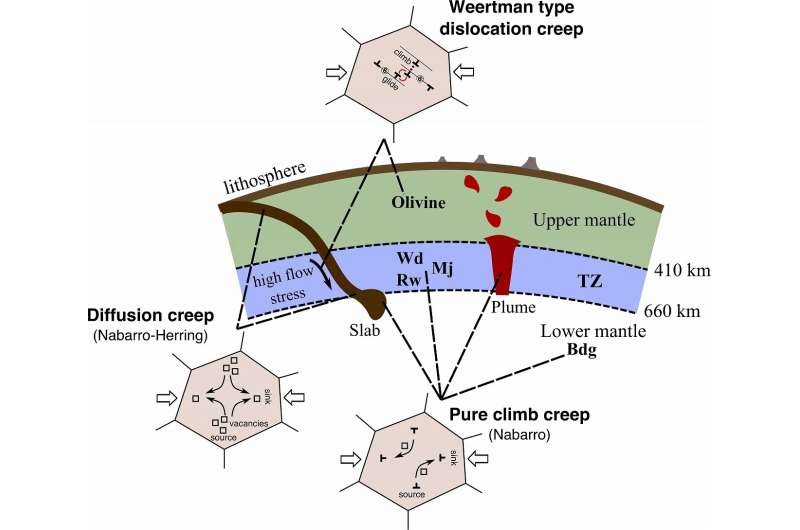Is the Earth's transition zone deforming like the upper mantle?

In a recently published paper in Earth and Planetary Science Letters, researchers from the Geodynamics Research Center, Ehime University and the University of Lille combine numerical modeling of dislocation glide and results from diffusion experiments to revisit the rheology of wadsleyite, ringwoodite and majorite garnet under geological strain rates across the transition zone of the Earth's mantle based on theoretical plasticity modeling.
Despite being composed of solid rocks, the Earth's mantle, which extends to a depth of ~2890 km below the crust, undergoes convective flow by removing heat from the Earth's interior. This process involves mass transfer by subduction of cold tectonic plates from and the ascent of hot plumes towards the Earth's surface, responsible for many large-scale geological features, such as Earthquakes and volcanism. Through a combination of previous seismological and mineral physics studies, it is well known that the Earth's mantle is divided (mineralogically) into two major regimes: the upper and the lower mantle, separated by the 'transition zone,' a boundary layer between ~410 and ~660 km depth. This transition zone influences the extent of whole mantle convection by controlling mass transfer between the upper and lower mantle. Seismic tomography studies (CT scan imaging of the Earth's interior using seismic waves) have previously revealed that while some slabs penetrate through the transition zone, others seem to stagnate either within or just below. The reason is unclear and the dynamics of the Earth's mantle across the transition zone remains poorly constrained due to the lack of understanding of its mechanical properties.
These mechanical properties depend on the ability of minerals to undergo slow plastic deformation in response to a low mechanical stress, called 'creep,' typically described by a parameter known as "viscosity." The dynamics of the upper mantle relies on plastic deformation of its main constituent, Mg2SiO4 olivine. The first ~300 km of the upper mantle is characterized by a strong directional dependence of the velocity of seismic waves, known as "seismic anisotropy." Therefore, it is generally believed that "dislocation creep"—a deformation mechanism inducing lattice rotation and crystallographic preferred orientations (CPO) in elastically anisotropic minerals as olivine—contributes to the overall deformation of the upper mantle. Dislocation creep is an intracrystalline deformation mechanism responsible for the transport of crystal shear, mediated by linear defects called "dislocations." It is a composite deformation mechanism that may involve both glide of dislocations along some specific crystal directions and planes and diffusion-mediated climb out of their glide planes. Indeed, recent numerical simulations of Boioli et al. (2015) have shown that deformation of Mg2SiO4 olivine crystals is accommodated by the Weertman type of dislocation creep under relevant upper mantle conditions, where climb of dislocations enables the recovery of dislocation junctions, allowing plastic strain to be efficiently produced by dislocation glide.

Entering the mantle transition zone beyond ~410 km depth with increasing pressure (P) and temperature (T), olivine transforms first into its high-P polymorph wadsleyite and at ~520 km into ringwoodite. It remains unclear if deformation processes of these more compact structures of the high-P polymorphs of olivine are similar to those of olivine (Ritterbex et al. 2015; Ritterbex et al. 2016). To address this question, researchers from the plasticity group at the University of Lille and the Geodynamics Research Center of Ehime University combined numerical simulations of thermally activated dislocation glide mobilities together with results from experimental diffusion data, and demonstrate that, in contrast to olivine at upper mantle conditions, dislocation climb velocities are exceeding those of glide in the high-P polymorphs of olivine, inducing a transition of deformation mechanism in the dislocation creep regime from Weertman creep to pure climb creep at geologic relevant stresses. Based on plasticity modeling and constrained by diffusion data from experiments, the current investigation quantifies steady-state deformation of the main transition zone minerals wadsleyite, ringwoodite and majorite garnet as a function of grain size.

These modelings are able to explain a number of key features associated with the mantle transition zone. It is shown that intracrystalline plasticity of wadsleyite, ringwoodite and majorite garnet by pure climb creep at geological stresses leads to an equiviscous transition zone of 10(21±1) Pa.s if the grain size is ~0.1 mm or larger, matching well the available inverted surface geophysical data which are typically used to constrain rheological properties of the Earth's mantle. Since pure climb creep does not induce lattice rotation and cannot produce CPO, deformation of the transition zone by this mechanism is compatible with its relative seismic isotropy compared to the upper mantle. The researchers also found that CPO is able to develop along with stress concentrations by the activation of Weertman creep, for example in corner flows around cold subducting slabs, something that could induce an increase in subduction resistance, explaining why some slabs stall at the base of the transition zone. On the other hand, viscosity reductions are predicted if grains are smaller than ~0.1 mm when the transition zone silicates are deforming by pure atomic diffusion, commonly referred to as "diffusion creep," which might potentially influence flow dynamics in the interior of cold subducting slabs or across phase transitions.
Future incorporation of these deformation mechanisms as a function of grain size in geodynamic convection models should enhance our understanding of the interaction between the upper and lower mantle and is expected to be helpful in constraining the geochemical evolution of the Earth.
More information: Sebastian Ritterbex et al, Deformation across the mantle transition zone: A theoretical mineral physics view, Earth and Planetary Science Letters (2020). DOI: 10.1016/j.epsl.2020.116438
Journal information: Earth and Planetary Science Letters
Provided by Ehime University



















